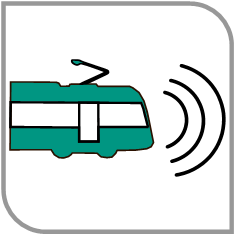Automatisierung
 |
Die Ressourcen- und Energieeffizienz des Eisenbahnverkehrs ist ein Enabler für die Verlagerung eines größeren Teils des Verkehrs auf die Schiene. Zur nachhaltigen Sicherung der steigenden Mobilitätsleistung, sowohl im Schienenpersonen- als auch im -Güterverkehr, stellt die Automatisierung der Systeme eine Schlüsseltechnologie dar. Im Forschungsbereich Automatisierung vereint der Institutsteil Bahnsystemtechnik (BST) am FAST die Kompetenzen von der Konzeptionierung über die System- und Funktionsentwicklung bis hin zur kontextrelevanten Verifikation und Validierung der Systeme. Dazu werden neue Methoden, wie der Einsatz virtueller Realität, XAI und digitaler Systemzwillinge beleuchtet und deren Bedeutung bei der Diffusion von künstlichen Intelligenzen in die Fahrzeugführung herausgestellt. Am FAST BST werden Methoden und Werkzeuge erforscht und entwickelt, mit denen sowohl in Simulationen als auch in Tests im Realfeld und im Modellmaßstab automatisierte Fahrfunktionen bis zur Stufe GoA4 (Grade of Automation 4) erprobt und sicherheitsrelevant getestet werden können. Die umfassende Institutsinfrastruktur bietet die Schnittstellen, zukunftsweisende Fragestellungen sowohl in öffentlich geförderten Forschungsvorhaben, in Kooperationen als auch in anwendungsnaher Auftragsforschung effizient zu adressieren. |
Virtual Automated Driving Laboratory
 |
virTrack is a mobile computing laboratory to both test and control highly automated vehicles. Either in lab or in field, virTrack enables coherent simulations for virtual and augmented metaverse testing.
|
virTrack-Method
| virTrack is an all-simulated photorealistic environment arising from research in automated shunting operation at KIT. The virTrack-method is the most efficient approach to simulate interfaces and information required to focus the key point, the automated driving high-level system development. |
|
Closed Loop Testing
Starting from simple sensor data simulations to holistic and coherent simultaneous real time manoeuvring and data emulation – virTrack enables test driven development of sub-systems to sound end-of-line validations.
Operational Design Domain
Simple scenes or complex scenarios, virTrack allows a flexible approach tailored to your specific use case.
Unreal Engine 5 ® Rendering
The photorealistic live rendering is more than a virtual representation of the infrastructure and terrain. Sensor models of most common perception systems can be sampled with customizable characteristics and resolutions
![]() GNSS Positioning
GNSS Positioning
![]() Odometry and Vehicle Kinematics
Odometry and Vehicle Kinematics
![]() RGB- /BW-Camera
RGB- /BW-Camera
![]() LiDAR
LiDAR
![]() Communication Protocols to Control Centre, etc.#
Communication Protocols to Control Centre, etc.#
Co-Simulated Vehicle Kinematics
The emulated sensor data is fed to the System Under Test (SUT). The driving decision is then forwarded to the Low-Level, a co-simulated vehicle model, controlling the velocity of the simulated vehicle within the virtual railway environment.
Test Run Evaluation
Predefined test runs come with ideal and expected system behaivor. Errors are detected automatically, an efficient approach to development and prototyping.
Virtual School Bench
The training data for this research is obtained from the virtual environment itself. One of the overall goals of virTrack and KITrain is to demonstrate the validity of virtual training data for real world application.
Research Ready for Metaverse Testing
 |
virTrack is ready to host a virtual twin of the in-field testing environment. Real world sensordata can be looped through the computing rack so that sensor data implants, customizable obstacles, such as wagons or humans can be augmented into the sensor data stream, for safe early stage vehicle-in-the-loop testing. |
Automated On-Sight Driving Systems
Development of safe highly automated on-sight driving systems for railway operation aims to represent the human drivers responsibility in each situation that might occur. At KIT, the KITrain - modular system architecture is under investigation applying deterministic and complex algorithms to face the challenges of future transport and mobility.

Target Pyramid of the modular highly automated on-sight driving system KITrain
For efficient testing and development, KIT presents virTrack, a virtual and augmented playground within a holistic and coherent environment.
Modular Automated Driving Stack “KITrain”
KITrain is a high-level driving decision making system, developed at KIT. It is the playground for academic exercises and front-row research in future mobility systems. KITrain has a modular system architecture and carefully designed interfaces.
In a first step KITrain instrumentalizes neural networking for object detection based on both, images and 3D point clouds. Parallel deterministic methods are used to verify the classifications and regarded in the sensor data fusion process. KITrain aims to take the application of complex algorithms to several higher steps and researches the potential of end-to-end systems rather than distributed consecutive subsystems.
Test Driven Development of KITrain – Closing the Loop with virTrack
The virTrack method is used to provide coherent sensor data, so that KITrain can be developed based on true, valid and coherent sensor data. Either if developing an interface, a subsystem or testing the entire system as a whole.


.png)
